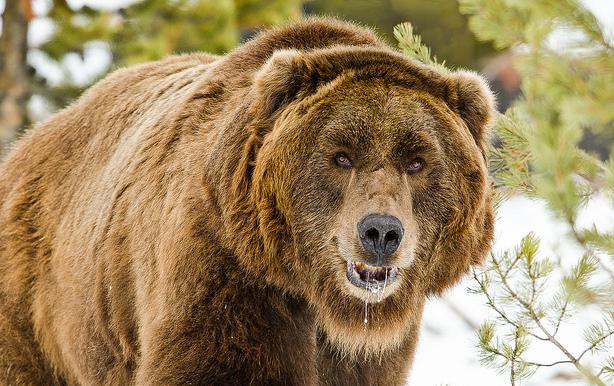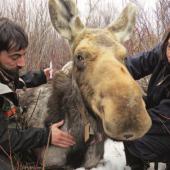Are Griz in Danger?
Grizzly bears, with their magnetic pull toward media attention, are polarizing the nation yet again. In April, the grizzlies in and around Yellowstone National Park were delisted from the Endangered Species list, sparking controversy over the future of these misunderstood giants. In Glacier National Park, another groundbreaking study to estimate the grizzly population is nearing completion, and questions regarding delisting will soon follow. Both Yellowstone and Glacier populations have been growing steadily since the dangerous lows of the 1970s. Scientists, however, doubt that the grizzlies of these two parks could withstand losing federal protection that would come with delisting.
The U.S. Fish and Wildlife Service believes a healthy population of more than 500 grizzlies exists in the area around Yellowstone. But over 250 scientists and researchers have opposed this decision. They doubt enough genetic diversity exists in the bear population for them to survive unprotected and under human pressures like global warming and increased development.
U.S. Geological Survey (USGS) researchers have identified at least 460 individual bears within an eight-million-acre swath of land in and around Glacier National Park. The study collects hair and DNA samples from the bears by using scented barbed wire, tree rubs, and scat samples. This noninvasive, bear-friendly approach can only give minimal information about total populations and trends.
The study showed that Glacier National Park holds one of the highest concentrations of grizzly bears in the lower 48 states, but researchers warn they are still years away from knowing whether a sufficient population exists to delist the bears in Glacier. The grizzly bear’s nomadic lifestyle, migrating through dense and near-impassable forests, makes it extremely challenging for researchers to accurately record sizes and trends. This means that, in turn, it’s nearly impossible to judge the healthiness of genetic diversity within the population and whether it could sustain delisting. The main factor contributing to a lack of genetic diversity is geographic isolation. The grizzly bear populations in Glacier and Yellowstone are isolated from other grizzly populations and are therefore unable to come in contact (and breed) with other groups. This threatens biological diversity by making the bears prone to inbreeding and thus more susceptible to environmental changes and human influences.
Increasing visitor numbers to these parks, while educationally necessary, brings bears into close contact with humans inside the protected walls of the parks. This habituates the bears toward humans, and inevitably leads to the bears' own demise as they wander outside the parks, across highways, and into the fields of gun-toting ranchers worried about their livestock. Encroaching golf courses and mountain estates, spilling onto the borders of our national and state parks, also severely threaten the livelihood of these mammalian giants. Even under federal protection, bear fatalities due to road building, poaching, and killing problem bears with a nose for human food are becoming all too common in recent years. Without federal protection one can only wonder what the future of grizzlies in Montana will be.
The announcement by Deputy Interior Secretary Lynn Scarlett to delist grizzly bears in Yellowstone could set a dangerous precedent for our other national parks, by prematurely declaring the existence of a “healthy population” for an animal that once roamed 98 percent of this country. The conservation strategy taken in and around Yellowstone over the next few years will likely determine the fate of grizzlies in Montana. The USGS researchers in Glacier are also close to finalizing an estimate of the grizzly population in the area, and delisting efforts by the federal government are likely imminent. If grizzlies are to survive, then it is up to local and state agencies, along with anyone visiting or living in grizzly bear habitats, to continue protecting these national treasures.
Bear-Essential Reading
In all its splendid forms the bear is one of the most revered creatures of the wild. And it’s not as if outdoor enthusiasts have much of a choice in that matter: not respecting these often vicious carnivores can land a hiker into a predicament from which no amount of bear-spray can offer salvation. If you care to marvel at these venerated beasts from a safer distance and perhaps learn how to keep them at such a range, you might want to check out a few of the following books.
David Smith’s Backcountry Bear Basics: The Definitive Guide to Avoiding Unpleasant Encounters is an essential read for anyone not well-versed in bear safety that is planning an excursion into the woods. It not only provides a thorough compendium of how to travel safely through bear country by avoiding potentially dangerous encounters, it also sheds truth on some commonly accepted yet erroneous bear myths.
Bears I Have Known by Bob Murphy provides a much more personal account of the titular animal. As a park ranger for over 50 years, the author has built up a wide array of first-hand accounts with bears that readers will find harrowing at times and tremendously entertaining throughout.
In the Company of Wild Bears: A Celebration of Backcountry Grizzlies and Black Bears by Howard Smith is a good hybrid of the styles presented in the previous two books. The author combines personal anecdotes of bear encounters with informative sidebars that educate and engage readers. Ultimately the book pays respect not only to this wondrous beast but—in a larger sense—to the great outdoors in general. After all, it’s not just a better understanding of bear safety but a developed knowledge of all the potential perils of backcountry adventuring that keeps us on the trail. In the wilderness, ignorance and bliss do not hike side-by-side.













